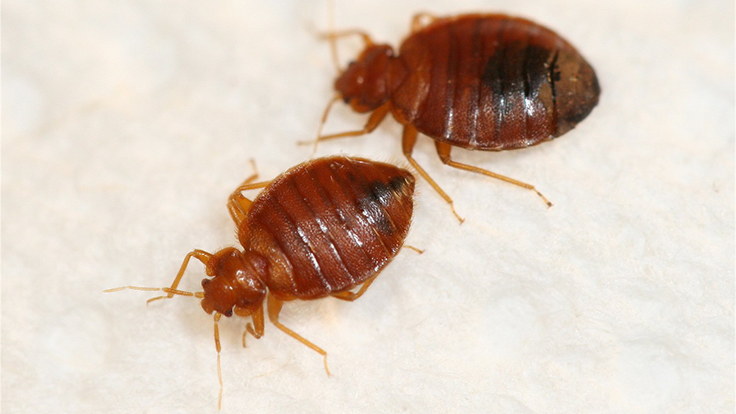Identify and Get Rid of Bed Bugs
Learn How to Protect Your Property by Identifying and Eliminating Bed Bugs
Bed bugs aren’t confined to dirty places. These tiny, dark-loving pests thrive in warm spots that have a ready supply of carbon dioxide and blood.
Research has found that at least 20% of Americans have either dealt with bed bugs or know someone who has.
These small blood-drinking critters can be found everywhere from mattresses and bed frames to stuffed animals and purses. Bed bugs affect homes and businesses across the country, and approximately 97% of pest management professionals have provided bed bug treatments within the past year.
Popular tourist cities, including Chicago, Washington D.C., and New York City, are regularly on the list of places with the highest bed bug infestations. With some upscale hotels revealed to be bed bug hot spots, many people are justifiably worried about taking the problem home.
It’s easier to avoid a full-blown infestation if you know what bed bugs look like and where they like to lurk. If you suspect a bed bug infestation, seeking professional help as soon as possible to obtain bed bug treatment increases the likelihood of eliminating the problem.
It’s important to understand that do-it-yourself efforts will not eliminate a bed bug infestation.
These public health nuisances breed quickly and become more challenging to eliminate as the infestation grows. It’s essential to understand not just how to get rid of bed bugs, but also how to identify bed bugs to ensure proper treatment.
How to Identify Bed Bugs
Many people initially confuse bed bugs with other pests, including fleas. Although adult bed bugs have a similar reddish-brown color, these critters sport a flat body that has an oval shape.
They have piercing mouthparts that allow them to break through skin and suck blood from their hosts. Nymphs have a shape that’s similar to adults, but their coloring starts out as translucent and becomes an opaque brown during the maturing process.
What bed bugs look like may matter less than signs of their presence. Most people who discover they have bed bugs after waking up with bites. In addition to seeing live bugs and bites, other telltale signs of bed bugs include:
- Bites: Bed bugs feed anywhere they can find exposed skin. The small bite marks start painless and typically become itchy welts.
- Stains: Rolling over and moving about can inadvertently crush bed bugs. When these pests get crushed, they leave behind red stains and streaks on linens and other surfaces.
- Dark Spots: Red stains aren’t the only marks bed bugs leave behind. Dark spots on fabric indicate excrement left from bed bugs.
- Eggs: Tiny, pale yellow fragments could indicate freshly hatched nymphs or skin left behind as nymphs mature.

Where Bed Bugs Hide
In addition to knowing how to identify bed bugs, it helps to know where they like to hang out. Bed bugs are notorious hitchhikers, it doesn’t take much for these pests to survive. Bed bugs attach themselves to clothing, hide in luggage, and use pets as a form of transportation.
They have been found on second-hand furniture, inside moving boxes, in office buildings, in clothing stores, on public transit, and almost anywhere else imaginable.
Bed bugs can live up to 300 days and lay one to five eggs per day — which is absolutely terrifying. The good news is bed bugs are not known to transmit diseases, and all infestations are treatable with the help of a professional.
Areas to check for live bed bugs and eggs include:
- Seams of mattresses and box springs
- Cracks in headboards and bed frames
- Between cushions and in seams of upholstered furniture
- Folds in draperies and curtains
- Inside electrical appliances and receptacles
- Behind wall hangings and in cracks where the ceiling meets the wall
How to Get Rid of Bed Bugs
Getting rid of bed bugs can be a significant challenge, which is why professional pest control is a must. Whether the infestation is in a residential or commercial location, pest control pros like Catseye Pest Control can help treat and eliminate bed bugs.
It takes a significant amount of effort, but the problem is not insurmountable. Professional treatment from Catseye relies on a combination of state-of-the-art freezing methods and monitoring to achieve effective, environmentally friendly control that targets specific areas of homes and businesses.
Although bed bugs can withstand cold temperatures as low as -13 degrees Fahrenheit, the pest cannot withstand being exposed to temperatures below 0 degrees Fahrenheit for several days. If exposed to extreme temperatures for an extended period of time, the freeloaders can be eliminated.
In addition to professional treatment and monitoring, it’s crucial to make the space less hospitable for these tiny bloodsuckers. Other helpful steps that homeowners, renters, and business owners can take include:
- Reducing clutter to reduce hiding spots.
- Washing linens, clothing, and stuffed animals in hot water and drying items on high heat.
- Scrubbing mattress and box spring seams with a stiff brush before thoroughly vacuuming.
- Repairing cracks and peeling wallpaper to reduce the number of potential hiding places.
- Using a special mattress cover to prevent bedbugs from entering or escaping the mattress.
Contact Catseye Pest Control for Professional Bed Bug Removal
Since female bed bugs can lay up to five eggs in a single day, it doesn’t take long for a small number of bed bugs to grow into a large infestation.
If even a single bed bug sign is spotted, don’t wait as it could already be a monstrous situation.
At the first sign of these pests, contact Catseye for professional control and monitoring that safely and effectively eliminates the problem.
The post Identify and Get Rid of Bed Bugs appeared first on Catseye Pest Control.
This article appeared first on Catseye Pest